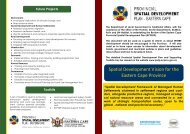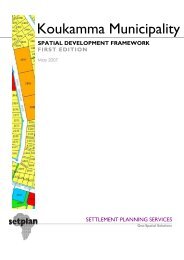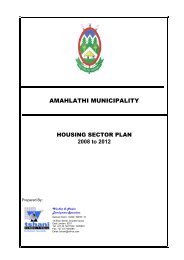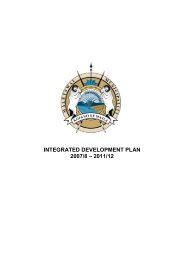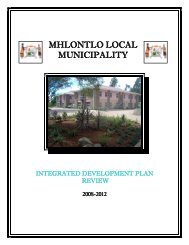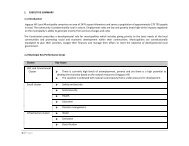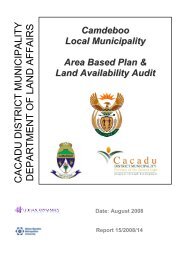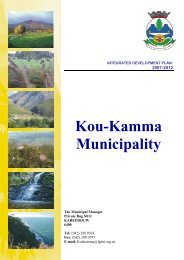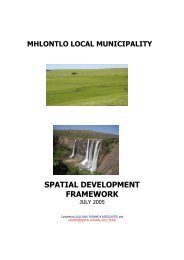Emalahleni Rural SDF_Phase 4.pdf - Provincial Spatial ...
Emalahleni Rural SDF_Phase 4.pdf - Provincial Spatial ...
Emalahleni Rural SDF_Phase 4.pdf - Provincial Spatial ...
You also want an ePaper? Increase the reach of your titles
YUMPU automatically turns print PDFs into web optimized ePapers that Google loves.
EMALAHLENI MUNICIPAL SPATIAL DEVELOPMENT FRAMEWORK October 20102. Land Use Management Guidelines2.1 INTRODUCTIONThe formulation of land use management guidelines is a legally requiredcomponent of a <strong>Spatial</strong> Development Framework.In complying with this requirement, it is important to be clear on what isunderstood by the term “land use management”, and therefore, how this istranslated into a set of usable guidelines, relevant to the Municipality and itsassigned roles and functions.The following excerpt from the White Paper on <strong>Spatial</strong> Planning and Land UseManagement (Dept Land Affairs, 2001) provides a broad definition of what, inessence, a Land Use Management System is expected to achieve in the newspatial planning system in South Africa: -“To implement a [<strong>Spatial</strong> Development Framework] it is clearly necessary… to have mechanisms inplace to encourage the desired types of land development. This makes the Municipal Systems Actterminology, land use management, appropriate, as it suggests a function that is broader than merelycontrolling development. [Therefore], the term land use management includes the followingactivities:• The regulation of land-use changes such as, for example, the rezoning of a property fromresidential to commercial use;• The regulation of ‘green fields’ land development, i.e. the development of previously undevelopedland;• The regulation of the subdivision and consolidation of land parcels;• The regulation of the regularization and upgrading process of informal settlements, neglected citycentres and other areas requiring such processes; and• The facilitation of land development through the more active participation of the municipality inthe land development process, especially through public-private partnerships.Land-use management has two main underlying rationales. The first is the widely felt resistance tothe idea of uncontrolled land development and the second is the commonly expressed wish byparticular sectors in society to promote various types of desirable land development.The resistance to uncontrolled development is motivated by a number of concerns: -• Environmental concerns: uncontrolled development of land can have adverse effects on naturalhabitats, cultural landscapes and air and water quality.• Health and safety concerns: uncontrolled development can lead to overcrowding and unsafebuilding construction. Certain land uses can also be detrimental to the health and safety ofneighbours.• Social control: the control of land uses and building types has long been a means of exertingsocial control, particularly through the exclusion of certain types of person, household oreconomic activity from certain areas through the application of particular development controlslimiting, for instance, plot sizes, plot coverage and home industries.• Efficiency of infrastructure provision and traffic management: increasingly it has become clearthat the where the granting of development permissions is not coupled with the provision ofadequate infrastructure and traffic management the consequences can be severe. Similarly, whereinfrastructure is provided, generally at high financial cost, without taking into account likely andrelevant land-use and settlement patterns the opportunity costs to society are very high.• Determination of property values for purposes of rating: the market value of land is the basis onwhich property valuation is determined and the extent and nature of the development permitted onthe land is a key factor in that determination.• Aesthetic concerns: the control of land development enables government to prescribe certaindesign parameters for buildings.The wish to promote desirable development is also driven by a number of different concerns:• The land development needs of the market seldom match precisely the social and political needs ofgovernment: government may well want to promote a type of land development in an area that themarket neglects. It then has to take certain steps to facilitate that development or provideincentives.• Investment promotion: changing the applicable land-use management instruments is often seen asa prerequisite for attracting certain types of investment to certain areas. This can take the form ofboth relaxing controls in those areas and increasing controls in other areas which might be morefavoured by the market. These strategies are likely to be linked to local economic developmentinitiatives”.2.2 LAND USE MANAGEMENT AND THE EMALAHLENIMUNICIPALITYWith due regard to the above, the setting of Land Use Management Guidelinesin a Local Municipal <strong>Spatial</strong> Development Framework poses some complexchallenges, given the fact that there is an absence of either a single or a suite ofenabling legislation that would permit the formulation of integrated land use4 | Page



